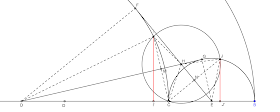The following problem, by Le Viet An (Vietnam), was posted on the Facebook group Perú Geométrico asking to prove that the smallest circles shown on the image are Archimedean circles. Here I give a proof for one of these circles.
I will give my own description of the problem and change the notation.
Consider an arbelos configuration with $D$, $E$, $O$ and $P$ being the centers of semicircles with diameters $AC$, $BC$, $AB$ and $DE$, respectively. Let $G$ be the intersection of semicircles $BC$ and $DE$. Denote by $H$ the midpoint of segment $BG=2a$. Call $I$ the intersection of a perpendicular line from $H$ to $AB$ and let $J$ be the intersection of $HI$ with the circle with radius $DE$. Denote by $K$ the intersection of $EJ$ with semicircle $BC$. Let $L$ be the intersection of $OK$ with semicircle $AB$. The circle with radius $KL$ is Archimedean (Le Viet An).
Notation:
$AD=CD=r_1$
$BE=CE=EK=r_2$
$DP=EP=GP=\frac{r_1+r_2}{2}$
$DE=EJ=r_1+r_2$
$BH=GH=a$
$KL=x$
Proof. First, let's find an expression for $a$. Focus on triangle $BGP$ and cevian $GO$. By the Stewart's theorem we have
$$(\frac{r_1+r_2}{2})^2r_2+4a^2(\frac{r_1+r_2}{2})=r_2^2(r_2+\frac{r_1+r_2}{2})+r_2(\frac{r_1+r_2}{2})(r_2+\frac{r_1+r_2}{2})$$
Solving for $a$ and simplyfing we get
$$a=\frac{r_2\sqrt{r_1+2r_2}}{\sqrt{2r_1+2r_2}}$$
Let $G'$ be on $AB$ such that $GG'$ is perpendicular to $AB$. Notice that $\triangle{BCG}\sim\triangle{BGG'}$, therefore,
$$\frac{BG'}{2a}=\frac{a}{r_2}$$
$$BG'=\frac{2a^2}{r_2}$$
As $H$ is the midpoint of $BG$ and $IH$ is parallel to $GG'$, then, $I$ is the midpoint of $BG'$. It follows
$$BI=\frac{a^2}{r_2}$$
$$HI=\sqrt{a^2-\frac{a^4}{r_2^2}}$$
$$EH=\sqrt{r_2^2-a^2}$$
By the Pythagorean theorem,
$$EI^2+IH^2=EH^2$$
$$EI=\sqrt{r_2^2-2a^2+\frac{a^4}{r_2^2}}$$
Replacing $a$ by its expression in terms of $r_1$ and $r_2$, we get
$$EI=\frac{r_1r_2}{2(r_1+r_2)}$$
Remark. notice that the circle with radius $2EI$ is also Archimedean.
Let $K'$ be the orthogonal projection of $K$ on $AB$.
$$\frac{EK'}{EI}=\frac{r_2}{r_1+r_2}$$
$$EK'=\frac{r_1r_2^2}{2(r_1+r_2)^2}$$
Focus on triangle $OKK'$. By the Pythagorean theorem,
$$KK'=\sqrt{(r_1+r_2-x)^2-[r_1+\frac{r_1r_2^2}{2(r_1+r_2)^2}]^2}$$
Now, focus on triangle $EKK'$, again, by the Pythagorean theorem,
$$(r_1+r_2-x)^2-[r_1+\frac{r_1r_2^2}{2(r_1+r_2)^2}]^2+\frac{r_1^2r_2^4}{4(r_1+r_2)^4}=r_2^2$$
Solving for $x$ and simplyfing we get two solutions for $x$,
$$x_1=\frac{r_1r_2}{r_1+r_2}$$
$$x_2=\frac{2r_1^2+3r_1r_2+2r_2^2}{r_1+r_2}$$
$x_2>r_1+r_2$, which is absurd from our configuration. Then,
$$x=\frac{r_1r_2}{r_1+r_2}$$
The following are some other problems by Le Viet An.
In an arbelos, from $E$, draw a tangent line to semicircle $AC$, at $F$. Construct $G$ similarly. Let $H$ be the intersection of tangent lines $EF$ and $DG$. Let circle $(H, HC)$ cut semicircles $AC$ and $BC$ at $I$ and $J$, respectively. Call $I'$ the orthogonal projection of $I$ onto $AB$. Construct $J'$ similarly. Let $S$ be the center of circle bounded by circle with center at A, radius $AJ'$, circle with center at $B$, radius $BI'$, and semicircle $AC$. Construct circle centred at $T$ similarly. Then, circles centred at $S$ and $T$ are Archimedean twins (Le Viet An).
Proof. Let $CI$ cut $DH$ at $M$. Let $CJ$ cut $EH$ at $N$. Notice that $CDIH$ is a kite, then, $CI$ is perpendicular to $DH$ and, as a consequence, $CM$ is parallel to $EG=r_2$. As $\triangle{CDM}\sim\triangle{EDG}$, we have
$$\frac{r_2}{\frac{CI}{2}}=\frac{r_1+r_2}{r_1}$$
$$CI=\frac{2r_1r_2}{r_1+r_2}$$
Remark. Notice that circle with radius $\frac{CI}{2}$ is Archimedean.
Notice also that $\triangle{CII'}\sim\triangle{EDG}$, then,
$$\frac{CI'}{r_2}=\frac{CI}{r_1+r_2}=\frac{\frac{2r_1r_2}{r_1+r_2}}{r_1+r_2}=\frac{2r_1r_2}{(r_1+r_2)^2}$$
$$CI'=\frac{2r_1r_2^2}{(r_1+r_2)^2}$$
Similarly, notice that $\triangle{CEN}\sim\triangle{DEF}$, then,
$$\frac{r_1}{CN}=\frac{r_1+r_2}{r_2}$$
$$CN=\frac{r_1r_2}{r_1+r_2}$$
Notice that $\triangle{CEN}\sim\triangle{CJJ'}$, then,
$$\frac{CJ'}{\frac{r_1r_2}{r_1+r_2}}=\frac{\frac{2r_1r_2}{r_1+r_2}}{r_2}=\frac{2r_1}{r_1+r_2}$$
$$CJ'=\frac{2r_1^2r_2}{(r_1+r_2)^2}$$
Focus on $\triangle{ASB}$ and cevian $DS$, if we call $x$ the radius of circle centred at $S$, from the Stewart's theorem we have
$$[2r_1+\frac{2r_1^2r_2}{(r_1+r_2)^2}-x]^2(r_1+2r_2)+[2r_2+\frac{2r_1r_2^2}{(r_1+r_2)^2}+x]^2r_1=$$
$$(2r_1+2r_2)[(r_1+x)^2+r_1(r_1+2r_2)]$$
Expanding, solving for $x$ and simplifying we get
$$x=\frac{r_1r_2}{r_1+r_2}$$
A similar reasoning goes for circle centred at $T$.
In an arbelos, let circle $(A, AC)$ cut semircircle $AB$ at $F$. Similarly, construct $G$. Call $D'$ the orthogonal projection of $D$ onto $BF$. Similarly, construct $E'$. Circles with centers at $D'$ and $E'$ and tagential to semicircles $AC$ and $BC$, respectively, are Archimedean (Le Viet An).
Proof. Notice that because of the Thales's theorem $AF$ is perpendicular to $BF$, therefore, $\triangle{ABF}\sim\triangle{BDD'}$. As a consequence,
$$\frac{2r_1}{r_1+x}=\frac{2r_1+2r_2}{r_1+2r_2}$$
Where $x$ is the radius of circle centred at $D'$.
Isolating $x$ and simplifying,
$$x=\frac{r_1r_2}{r_1+r_2}$$
A similar reasoning goes for circle centred at $E'$.
In an arbelos, let semicircle $DE$ cut semicircles $AC$ and $BC$ in $F$ and $G$, respectively. Let $H$ be on chord $DF$ such that $\angle{CHF}=90^\circ$. Similarly, construct $I$. Then, circles with radii $HF$ and $IG$ are Archimedean (Le Viet An).
Proof. Because of Thales's theorem, $DF=r_1$ is perpendicular to $EF$. As a consequence, $\triangle{CDH}\sim\triangle{EDF}$. It follows
$$\frac{r_1}{DH}=\frac{r_1+r_2}{r_1}$$
$$DH=\frac{r_1^2}{r_1+r_2}$$
$$FH=r_1-\frac{r_1^2}{r_1+r_2}=\frac{r_1r_2}{r_1+r_2}$$
A similar reasoning must show the congruency for circle with radius $GI$.
In an arbelos, let the circle $(B, BC)$ meet semicircle $AB$ in $F$. Similarly, construct $I$, on semicircle $AB$. Let $AF$ intersect semicircle $AC$ in $G$. Let $G'$ be the orthogonal projection of $G$ onto $AB$. The circle centred at $R$ is bounded by semicircle $AB$, circle $A(C)$ and the line $GG'$. Similarly, construct the circle centred at $S$. Then, the circles centred at $R$ and $S$ are Archimedean (Le Viet An).
Proof. Notice that because of Thales's theorem $\angle{AGC}=\angle{AFB}=90^\circ$. Therefore, $\triangle{AGC}\sim\triangle{AFB}$. Thus, we have
$$\frac{GC}{2r_2}=\frac{2r_1}{2r_1+2r_2}$$
$$GC=\frac{2r_1r_2}{r_1+r_2}$$
Remark. Notice that the circle with radius $\frac{GC}{2}$ is Archimedean.
$$AF=\sqrt{(2r_1+2r_2)^2-4r_2^2}=2\sqrt{r_1^2+2r_1r_2}$$
$$\frac{AF}{AG}=\frac{2r_1+2r_2}{2r_1}$$
$$AG=\frac{2r_1\sqrt{r_1^2+2r_1r_2}}{r_1+r_2}$$
$$GC=\sqrt{4r_1^2-AG^2}=\sqrt{4r_1^2-\frac{4r_1^2(r_1^2+2r_1r_2)}{(r_1+r_2)^2}}$$
$$GC=\frac{2r_1\sqrt{4r_1r_2+r_2^2}}{r_1+r_2}$$
As $\triangle{AGG'}\sim\triangle{AGC}$, it follows
$$\frac{AG'}{AG}=\frac{AG}{AC}$$
$$AG'=\frac{2r_1(r_1^2+2r_1r_2)}{(r_1+r_2)^2}$$
Let $R'$ be the orthogonal projection of $R$ onto $AB$. If we call $x$ the radius of circle centred at $R$, by the Pythagorean theorem,
$$RR'=\sqrt{(2r_1+x)^2-(AG'-x)^2}$$
Focus on triangle $\triangle{ORR'}$. By the Pythagorean theorem
$$[AO-(AG'-x)]^2+RR'^2=OR^2$$
If we replace the segments by their expressions in terms of $r_1$ and $r_2$, we have the following equation
$$[(r_1+r_2)-\frac{2r_1(r_1^2+2r_1r_2)}{(r_1+r_2)^2}+x]^2+(2r_1+x)^2-[\frac{2r_1(r_1^2+2r_1r_2)}{(r_1+r_2)^2}-x]^2=(r_1+r_2+x)^2$$
Expanding, solving for $x$ and simplifying you get
$$x=\frac{r_1r_2}{r_1+r_2}$$
A similar reasoning goes for circle centred at $S$.



















